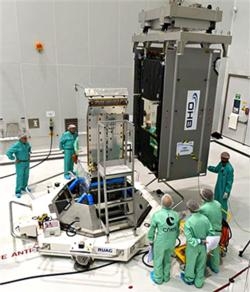Sun, Aug 17, 2014
Two Navigation Satellites To Be Delivered To Orbit August 21
The first of two Galileo navigation satellites to be orbited on Arianespace’s August 21 Soyuz flight has been integrated on its payload dispenser system, marking a key step as preparations advance for this medium-lift mission from French Guiana.

Named “Doresa,” the spacecraft was installed this month during activity inside the Spaceport’s S5A integration hall. It is to be joined on the dispenser system by the mission’s other passenger – “Milena,” whose own installation is forthcoming – in a side-by-side arrangement. The pair then will be mated atop Soyuz’ Fregat upper stage and encapsulated in the protective payload fairing.
“Doresa” and “Milena” – both built by OHB System – are the first FOC (Full Operational Capability) satellites for the Galileo constellation, which will create a European-operated space-based navigation system providing highly accurate, guaranteed global positioning services.
The FOC phase is being funded and executed by the European Union, with the European Space Agency designated as the Galileo system’s development and sourcing agent. The spacecraft payloads, which will generate precision positioning measurements and services to users worldwide, were supplied by Surrey Satellite Technology Ltd. in Guildford, UK.
Designated VS09 in Arianespace’s numbering system, the August 21 flight will be performed from the purpose-built ZLS launch facility for Soyuz – located in the Spaceport’s northern sector near the city of Sinnamary.
Next week’s mission continues Arianespace’s support in the overall Galileo system development. The company’s Starsem affiliate lofted two GIOVE (Galileo In-Orbit Validation Element) satellites in December 2005 and April 2008 on Soyuz missions conducted from Baikonur Cosmodrome in Kazakhstan.
These were followed by four Galileo satellites used for the system’s In-Orbit Validation (IOV) phase, launched in pairs on Soyuz flights performed by Arianespace from French Guiana in October 2011 and October 2012.
(Image provided by Arianespace)
More News
Aero Linx: Model Aeronautical Association of Australia MAAA clubs are about fun flying, camaraderie and community. For over 75 years, the MAAA has been Australia’s largest fl>[...]
Touchdown Zone Lighting Two rows of transverse light bars located symmetrically about the runway centerline normally at 100 foot intervals. The basic system extends 3,000 feet alon>[...]
“Discovery and innovation are central to our mission at Virgin Galactic. We’re excited to build on our successful record of facilitating scientific experiments in subor>[...]
How To Get A Story On Aero-TV News/Feature Programming How do I submit a story idea or lead to Aero-TV? If you would like to submit a story idea or lead, please contact Jim Campbel>[...]
Student Pilot Reported That During Rotation, “All Of A Sudden The Back Of The Plane Kicked To The Right..." Analysis: The student pilot reported that during rotation, “>[...]
 ANN's Daily Aero-Linx (05.02.24)
ANN's Daily Aero-Linx (05.02.24) ANN's Daily Aero-Term (05.02.24): Touchdown Zone Lighting
ANN's Daily Aero-Term (05.02.24): Touchdown Zone Lighting Aero-News: Quote of the Day (05.02.24)
Aero-News: Quote of the Day (05.02.24) ANN FAQ: Contributing To Aero-TV
ANN FAQ: Contributing To Aero-TV NTSB Final Report: Cirrus Design Corp SR20
NTSB Final Report: Cirrus Design Corp SR20



